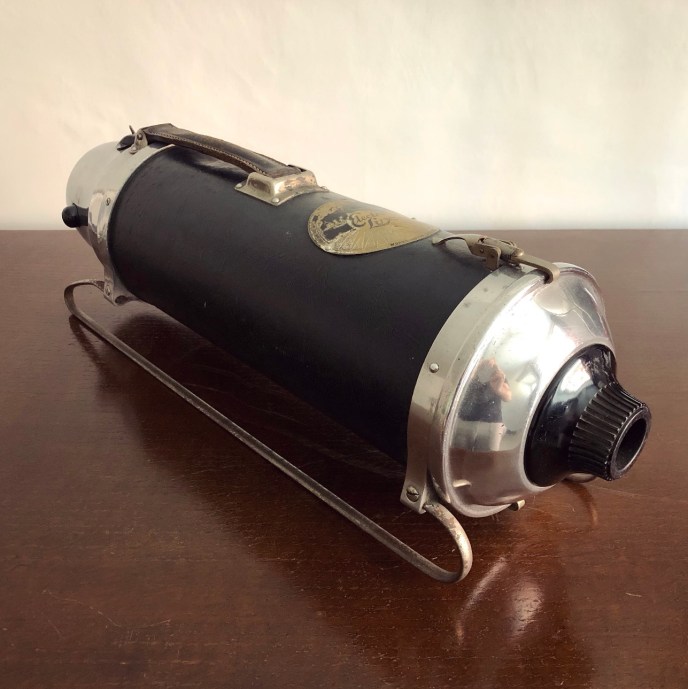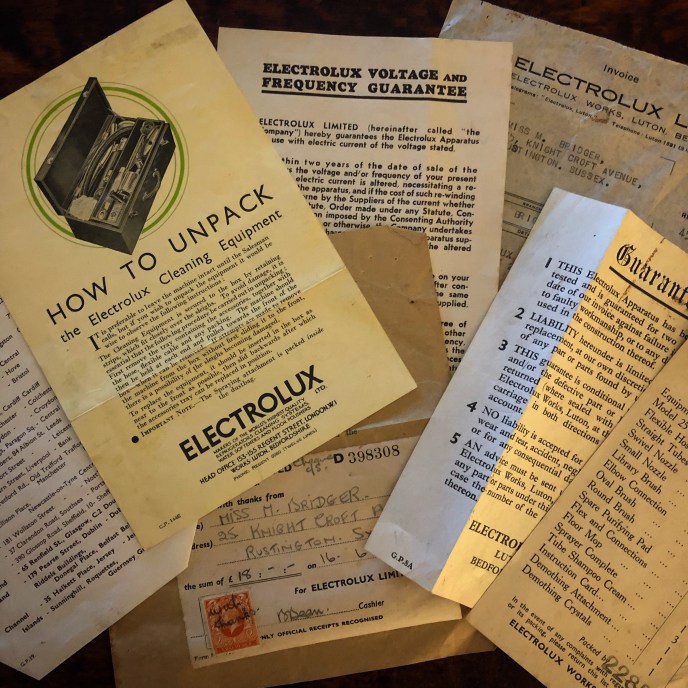Electrolux Model V – c.1921

‘All the awkward cleaning is more easily done with Electrolux. You cannot afford to choose your vacuum cleaner before seeing an Electrolux demonstration’
Simple, solid and clad in a reddish-brown leatherette, Model V was the first Electrolux vacuum sold in the UK. Designed for use both as a regular cylinder vacuum with hose, wand and tools, and also in stick vacuum format, it included a strap so the user could wear it over their shoulder when using the hose and tools for dusting tasks.

Earliest examples don’t include runners. Later examples included a round wire cradle runner design that could be attached or removed as needed, as pictured above. Later production variations include runners of first round then flat steel, permanently fixed to the machine.

The pistol hand grip provided a handle for the user when cleaning in stick vacuum format, and incorporated an on/off slider switch. The textured Bakelite inserts featured an elephant motif. The power cord was permanently attached to the machines, unlike later Electrolux cylinders which had power cords that could be removed and stored separately.
Even on their first machine, Electrolux included a pre-motor filter in addition to the cloth shake-out bag, and emphasised the importance of effective air filtration in battling ‘disease-laden germs’.
Electrolux Model XI – c.1926

‘Give her Pleasure – Give her Leisure – Give her an Electrolux for Christmas. The wonderful cleaner than every woman covets!’
Electrolux continued to iterate and improve on their basic design. By 1926, Model XI had taken on the format and layout of a traditional cylinder vacuum cleaner, losing the stick vacuum option. Wrapped in a dark greenish-grey leatherette, it also gained a more powerful 230w motor.

By unscrewing the black Bakelite hose connection piece from the front of the machine and attaching it to the rear casing, the user could make use of the jet of exhaust air. Electrolux suggested this could be useful for airing pillows and mattresses, blowing out dust from inside radio sets, and even drying hair!

The power cord connected to the machine using a Bayonet-style fitting, and could be removed for separate storage. This also meant the cord was easy to replace when worn or damaged. Later examples featured cords that connected via a 2-pin plug fitting.

Electrolux Model 25 E – c.1933-45

‘Simplicity is the keynote. After a little experience with your new Electrolux you will find it a veritable boon in home-cleaning.’
With a bottle green, black grained leatherette finish, Model 15/25 was a larger and heavier machine than Model XI.
Model 25 and its standard tools could be stored on the Electrolux ‘All-Ready’ rack – a stained, polished wood wall mounting fixture. But buyers who purchased Model 25E received an Equipment Box – a polished wood storage trunk which held the vacuum and a range of additional tools not included with the standard model, such as the library brush, the dry polisher and the demother.


This machine has the distinction of being the first Electrolux vacuum to include a bag-full indicator, in the form of a simple pressure valve. When the pores of the cloth bag clogged with fine dust and airflow through the machine was impeded, a red indicator was displayed through the small clear window on top of the machine.

For the first time, the rear casing was made of marbled green Bakelite rather than polished aluminium.



Electrolux Model XXX (US) – c.1937

An iconic design frequently referenced by scholars of Art Deco and machine age design, the American Model XXX was styled by Lurelle Guild. It was never sold in the UK.

Like upright vacuums General Electric Model 111 and Hoover Model 800, Electrolux Model XXX was an early example of streamlined styling touches being applied to a traditionally-mundane appliance like a vacuum cleaner. At a time when customers expected their expensive appliances to last a lifetime without replacement, eye-catching styling increased the desirability of newer products, and helped to stimulate sales.


Electrolux Model 55 – c.1949

As Britain emerged from WWII, manufacturers like Electrolux and Hoover resumed production of their consumer products. They sought to refresh their ranges, as the machines they had been selling in 1939 were starting to look a little dated. In 1946 Electrolux launched Model 30, introducing a sleek, clean new body shape with a reddish-brown and black grained leatherette finish.

1949’s Model 55 was essentially the same machine as Model 30 but with a new crocodile-effect grey leatherette body, a brighter colourway that further modernised the design. Glossy black Bakelite endpieces and shiny chrome trim added to the premium feel of the appliance.



Electrolux Turbo Polisher attachment – c.late 1950s

Suitable for Models 55 and 62, the Turbo Polisher attachment allowed Electrolux vacuum owners without a separate electric floor polisher to wax and buff their hard floors. Powered by an innovative clean-air turbine mechanism, it used the machines airflow to drive the polisher. A mesh intake protected the turbine from fluff and debris, and curved guide vanes directed the airflow.

Constructed of die cast aluminium, it had a gunmetal grey hammerite finish. An outer ring of fixed bristles provided support for the inner rotating polishing disk. Equipped with a range of interchangeable brushes and buffing pads, it was designed to polish and wax a range of hard floor types, as well as wooden furniture and even car paintwork.




Electrolux Twin 504 Super upright vacuum cleaner, c.1974
 The innovative Electrolux 500 series represented a genuine step-change in upright vacuum design, and brought a truly multi-functional clean-air upright to market after Hoover’s initial attempt with their earlier Convertible/Dial-A-Matic/Dynamatic range.
The innovative Electrolux 500 series represented a genuine step-change in upright vacuum design, and brought a truly multi-functional clean-air upright to market after Hoover’s initial attempt with their earlier Convertible/Dial-A-Matic/Dynamatic range.

The colourway is ‘rich golden yellow and midnight blue, with brushed aluminium trim’.

Model 504 had a range of appealing features including carpet height and suction controls, multi-level air filtration, a whistle bag-full indicator and an illuminated on/off switch.

Dust bags dropped and lifted easily in and out of place, and the hose slotted simply into a port at the rear of the machine for above-floor cleaning.


Electrolux 612 Electronic (Z612E), c.1987

‘The Electrolux vac with the hose at the back!’
 When launched in 1986, the Electrolux 612 Electronic was the UK’s first mass-produced domestic upright vacuum to include an onboard hose.
When launched in 1986, the Electrolux 612 Electronic was the UK’s first mass-produced domestic upright vacuum to include an onboard hose.



